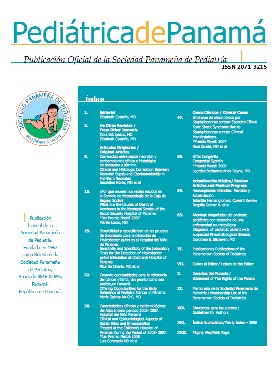Comparison of a scale, an index and a biomarker as predictors of mortality in children with septic shock admitted to the intensive care unit of the Dr. José Renán Esquivel hospital. August 2015- March 2016
1,
1,
1,
1
In the pediatric population, septic shock is an entity associated with high mortality and morbidity rates. In the intensive care unit, it is important to estimate the risk of death of the patients admitted in order to re-direct the goals of treatment. However, the lack of consistency and the subjectivity of the clinician have been determinant factors for the development of mortality scales with the purpose of achieving accurate quantitative measurements. Many scales, indexes and biomarkers exist which have been developed to predict mortality. Among these are the PIM-2 scale, the shock index and serum lactate.
Objective: To compare the PIM-2 scale, the shock index and serum lactate as early markers of mortality in children with septic shock.
Methods: A prospective cohort study was performed in which all patients with septic shock criteria admitted to the intensive care unit of the Hospital del Niño between August 2015 and March 2016 were included. Calculations of PIM-2, shock index and serum lactate value at admission of the surviving and the deceased patients were performed, and the results of these markers were compared as predictors of mortality.
Results: The PIM-2 scale resulted in an excellent mortality predictor with an under the curve area of 94% compared to the shock index which oscillated between 53 and 61%, and the value of lactate which was of 77%. Conclusion: The PIM-2 scale turned out to be a simple, free and easy to calculate test, with an excellent sensibility to predict mortality in critically ill children with septic shock. Despite the ease of use of the shock index, it resulted to be a poor predictor of mortality. However, it should be correlated with other scales since it can be biased by other causes which produce its increase or decrease.
Show Affiliation
Authors
DOI:
https://doi.org/10.37980/im.journal.rspp.20181625Keywords:
septic shock, shock index, PIM-2, lactacte, mortalityAbstract
Summary:In the pediatric population, septic shock is an entity associated with high mortality and morbidity rates. In the intensive care unit, it is important to estimate the risk of death of the patients admitted in order to re-direct the goals of treatment. However, the lack of consistency and the subjectivity of the clinician have been determinant factors for the development of mortality scales with the purpose of achieving accurate quantitative measurements. Many scales, indexes and biomarkers exist which have been developed to predict mortality. Among these are the PIM-2 scale, the shock index and serum lactate.
Objective: To compare the PIM-2 scale, the shock index and serum lactate as early markers of mortality in children with septic shock.
Methods: A prospective cohort study was performed in which all patients with septic shock criteria admitted to the intensive care unit of the Hospital del Niño between August 2015 and March 2016 were included. Calculations of PIM-2, shock index and serum lactate value at admission of the surviving and the deceased patients were performed, and the results of these markers were compared as predictors of mortality.
Results: The PIM-2 scale resulted in an excellent mortality predictor with an under the curve area of 94% compared to the shock index which oscillated between 53 and 61%, and the value of lactate which was of 77%. Conclusion: The PIM-2 scale turned out to be a simple, free and easy to calculate test, with an excellent sensibility to predict mortality in critically ill children with septic shock. Despite the ease of use of the shock index, it resulted to be a poor predictor of mortality. However, it should be correlated with other scales since it can be biased by other causes which produce its increase or decrease.
Downloads
Published
2020-11-09
Issue
Section
Artículos originales
License
Copyright (c) 2020 Infomedic InternationalDerechos autoriales y de reproducibilidad. La Revista Pediátrica de Panamá es un ente académico, sin fines de lucro, que forma parte de la Sociedad Panameña de Pediatría. Sus publicaciones son de tipo gratuito, para uso individual y académico. El autor, al publicar en la Revista otorga sus derechos permanente para que su contenido sea editado por la Sociedad y distribuido Infomedic International bajo la Licencia de uso de distribución. Las polítcas de distribución dependerán del tipo de envío seleccionado por el autor.






